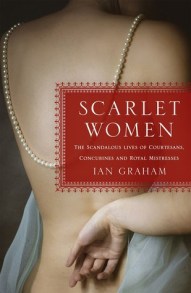 Scarlet Women: The Scandalous Lives of Courtesans, Concubines, and Royal Mistresses
Scarlet Women: The Scandalous Lives of Courtesans, Concubines, and Royal Mistresses
By: Ian Graham
“In 1965, an impoverished elderly woman was found dead in Nice, France. Her death marked the end of an era; she was the last of the great courtesans. Known as La Belle Otero, she was a volcanic Spanish beauty whose patrons included Kaiser Wilhelm II, the Prince of Wales (later King Edward VII) and Grand Duke Nicholas of Russia. She accumulated an enormous fortune, but gambled it all away. Scarlet Women tells her story and many more…
Courtesans were an elite group of talented, professional mistresses. The most successful became wealthy and famous in their own right. While they led charmed lives, they occupied a curious position: they enjoyed freedom and political power unknown to most women, but they were ostracized by polite society. From the hetaerae of ancient Greece to the cortigiani onesti of 16th century Venice, the oiran of Edo-period Japan to the demimondaines of 19th century France, this captivating book–perfect for readers of A Treasury of Royal Scandals–uncovers the rich, colorful lives of these women who dared to pursue fortunes outside their societies’ norms.”
The concept of this book had a lot of potential. It could have been truly revealing of the impact women had on history and the influential men they slept with in order to rise to power, wealth and notoriety. Instead, Graham wrote this book more as a gossip column, divulging salacious “secrets” of the women who bedded men of great power and wealth. The tone of this book borders on mocking and doesn’t deliver the proper respect these women garnered during their times with kings, noblemen, and knights.
I would have liked a more scholarly approach to the topic. I felt Graham should integrate some of these women into a narrative that explained more about the courtesan life. He mentions many times how women were schooled in the art of the courtesan. What does that mean? Who taught them? What were they taught? Many of the women took to the stage as dancers and singers to gain notoriety or to earn money. What kind of singing and dancing? How could amateurs so easily become stars? Today singers and dancers endure grueling years of lessons and practice. It must have been different in earlier centuries, but how? These are the kinds of things I would have liked to know.
The sketches of the courtesans, concubines and mistresses are brief – so brief that they start to blend together and feel the same as the previous one. If Graham had no intention of going into detail about the lives of these women, he certainly achieved that. This book felt more like a list of names of women who slept with men, their rise to fame and then their decent into madness, poverty and eventually death. I would have preferred to read a book about five or six mistresses, well written, researched and in depth, rather than a book full of every possible mistress and just a brief few paragraphs about each of them. 6/10.